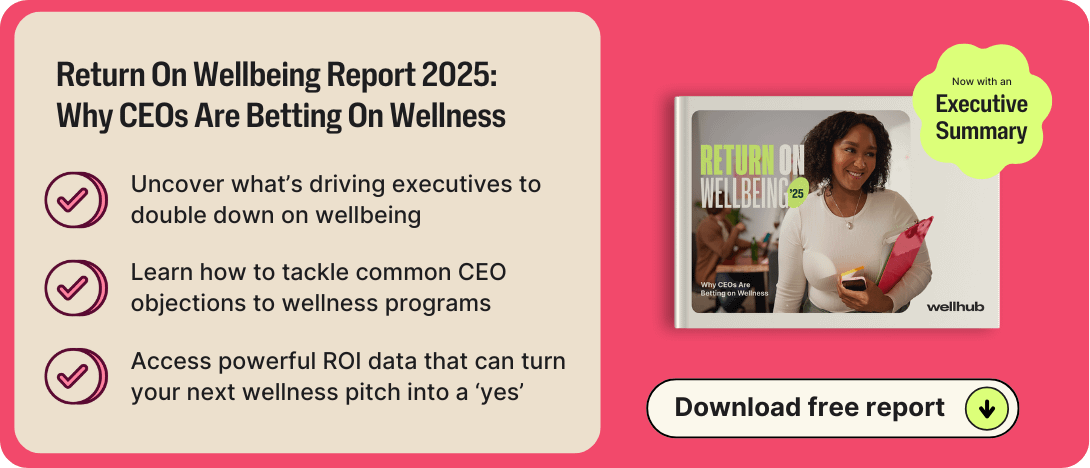Why CEOs Are Betting Big on Employee Wellbeing
Last Updated Jul 3, 2025

Wellness is a fundamental part of life and work. Thriving people drive thriving businesses. Companies that overlook employee wellbeing risk falling behind because resilience, productivity, and creativity all rely on health.
I experienced this personally. Growing up in a small town in Brazil, wellness wasn’t something we planned or pursued; it was embedded in daily life. We had sunny days, fresh air, and plenty of movement, naturally and effortlessly. But once I began my professional journey—as an analyst, consultant, and later executive—I saw how easily wellbeing could slip away. Long hours, endless pressure, constant deadlines: wellness quickly became an afterthought, and I paid the price.
I felt it in my health, my performance, and my relationships—and I knew I wasn't alone. That realization sparked the vision behind Wellhub: to make wellness accessible, especially for busy professionals, directly supported by their workplaces.
Leadership sets the tone. CEOs have the unique power to make wellness a priority just as essential as retirement plans or health insurance.
Today, I’m proud to share Wellhub's latest report: Return on Wellbeing 2025: Why CEOs Are Betting on Wellness. We surveyed over 1,500 executives globally and discovered a powerful link between CEO involvement and the success of wellness initiatives. Leaders who actively participate don't just enhance their own wellbeing; they inspire greater investment, boost employee engagement, and generate stronger business outcomes.
The message couldn't be clearer: When CEOs champion wellness, everyone wins.

Key Finding 1: CEOs Embrace Wellness as Essential, but Employees Feel a Disparity
What We Found: Executive leaders widely accept that wellbeing isn't just an HR issue—it's their corporate responsibility. Our survey reveals:
- 58% of CEOs strongly agree that wellbeing is critical to their organization’s financial success.
- 60% strongly believe employee wellness is their company’s responsibility.
- 74% say top talent will only consider working for their company if they demonstrate a clear wellbeing commitment.
However, there's a meaningful gap between what CEOs perceive and what employees actually experience:
- 98% of CEOs report improved wellbeing over the past year, yet only 50% of employees say the same.
The Takeaway: This disconnect poses a real risk to employee performance, engagement, and retention. It’s crucial for HR leaders to bridge this gap, aligning leadership intentions with employee realities by developing wellness programs that are inclusive, accessible and genuinely address employee needs.
Key Finding 2: CEOs are Taking Notice of the Real ROI of Wellness
What We Found: Data is what turns wellness initiatives from good ideas into strategic priorities. CEOs clearly see the financial impact wellness investments deliver:
- 88% report positive ROI from wellness programs
This is because:
- 47% say workforce productivity is extremely impacted.
- 73% report improved retention.
- 67% note decreased absenteeism.
The Takeaway: Wellness isn’t soft HR—it's solid business. CEOs invest in wellbeing because it produces measurable, tangible benefits for the entire organization.
Key Finding 3: The CEOs Who Thrive Are the Ones Who Invest—and Participate
What We Found: The strongest wellness programs start at the top. CEOs who personally engage in wellness activities experience first hand the benefits and are significantly more likely to support and fund their programs:
- Leaders with high personal wellbeing are nearly twice as likely to increase wellness budgets.
Moreover, CEOs who actively participate reap substantial benefits:
- CEOs who participate in their company’s wellness programs daily report the strongest gains across every dimension of wellbeing - i.e. physical health, mental health, nutrition, sleep.
Still, disparities exist between executive and employee experiences, driven by barriers such as inflexible schedules and restricted program access.
The Takeaway: HR leaders have a powerful opportunity to get their CEO involved in the wellness program to improve their own wellness routines and be a leader to drive adoption throughout the entire organization, bridging gaps and supporting wellbeing for every employee.
Key Finding 4: HR Leaders Must Turn Skepticism into Strategy
What We Found: Even CEOs who genuinely value wellness have reservations about effectiveness, ROI, and employee engagement:
- 30% of CEOs say employee engagement rates in the program are their top concern when it comes to investing in the program, which makes it the largest C-suite worry overall.
- CEOs require clear ROI metrics to justify investments.
Successful HR leaders proactively tackle these concerns by:
- Providing robust data on employee demand and wellness impact.
- Demonstrating tangible results through pilot programs.
- Regularly delivering impactful reports highlighting key business outcomes.
When the impacts of wellness programs are communicated clearly and frequently, CEO investment grows significantly:
- 58% of CEOs who receive monthly updates substantially increased wellness funding last year.
The Takeaway: Consistent, strategic reporting is essential for turning CEO belief into committed investment.
https://www.youtube.com/watch?v=ZToR3EEB7m4&ab_channel=Wellhub
Key Finding 5: The Future of Wellness: Personalized, Mindful, and Flexible
What We Found: Wellness initiatives are evolving fast, becoming increasingly personalized and technology-driven:
- Nearly half of CEOs plan increased investment in mental health.
- 41% see personalized wellness offerings as essential.
- Over half identify schedule flexibility as the key factor in employee wellness success.
The Takeaway: The future of effective wellness programs is personalized, adaptable, and seamlessly integrated into employees' daily routines.
Better Leaders, Better Businesses
As CEOs and HR leaders, we share a vital responsibility: prioritizing wellness. When leaders genuinely embrace wellbeing, the entire organization thrives.
I understand the common concerns and hesitations, but I’ve witnessed how purposeful investment in wellness can fundamentally transform a company's success, culture, and performance.
The future belongs to businesses that understand their greatest asset is their people and invest accordingly. That transformation begins with leadership. It begins with us.
Discover more insights, practical strategies, and actionable steps in our latest report, Return on Wellbeing 2025.

Company healthcare costs drop by up to 35% with Wellhub*
See how we can help you reduce your healthcare spending.
Category
Share

Cesar Carvalho is the CEO and Co-Founder of Wellhub, a corporate wellness platform that connects employees to the best partners for fitness, mindfulness, therapy, nutrition, and sleep, all included in one subscription. A champion of wellbeing, he is one of millions of employees who use Wellhub to move, eat, sleep, and feel better, leading to better engagement and productivity at work. At Wellhub, Carvalho and his team have developed a formula that more than doubles the number of employees engaged with wellness.
Originally from Brazil and now based in New York, Carvalho launched Wellhub while attending Harvard Business School. He previously held leadership roles at McKinsey & Company and AC Nielsen. Carvalho has been recognized with a number of awards, including Best Large Company CEO by Comparably (2023 and 2024), Ernst & Young Entrepreneur of the Year, New York, Goldman Sachs 100 Most Intriguing Entrepreneurs and one of the Top 25 Best CEOs for Diversity and Women. He received a Bachelor's Degree in Business from the Universidade de São Paulo.
Subscribe
Our weekly newsletter is your source of education and inspiration to help you create a corporate wellness program that actually matters.
Subscribe
Our weekly newsletter is your source of education and inspiration to help you create a corporate wellness program that actually matters.
You May Also Like

Corporate Wellness Trends HR Must Know for 2026 | Wellhub
See the top 2026 wellness trends shaping performance, retention, and culture—plus how HR can build a unified, ROI-driven wellbeing strategy.

Wellness Points Programs: Boost Employee Health & Engagement | Wellhub
Turn your workplace wellness strategy around with a points program that rewards healthy behavior with perks, from extra time off to gift cards.

Employee Financial Wellness Programs: Ultimate HR Guide | Wellhub
Create an effective financial wellness program that supports your employees in their financial needs, boosting productivity and retention.